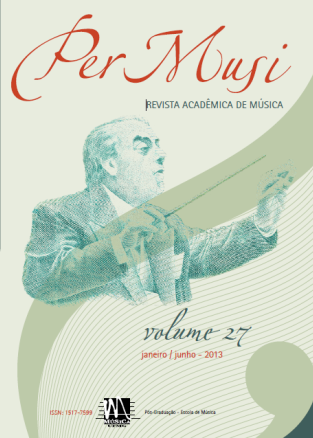How La llorona became a Miserere by Willy Corrêa de Oliveira
Keywords:
Willy Corrêa de Oliveira, Miserere, Metalanguage, Musical memory, Brazilian contemporary musicAbstract
In our research on the cycle of piano pieces called Miserere, by Brazilian composer Willy Corrêa de Oliveira (DE BONIS, 2010) we discuss a series of compositional procedures used in this work and in the composer’s production in general, such as borrowings and metalanguage, the relation to visual arts, the condensation of ideas, the superposition of quotations in the manner of an ideogram, musical theater, and the possibility of an structural analysis of each piece side by side with a semantic reading (favored by the score itself). As an open work, the Miserere has received additions by the composer after the publication of this research. The same analytical tools applied to the cycle are here used to study one of the last pieces to join the cycle in 2009.
References
CAMPOS, Haroldo de (org.). Ideograma: lógica, poesia, linguagem. São Paulo: Cultrix; Edusp, 1994.
DE BONIS, Maurício. O Miserere de Willy Corrêa de Oliveira: “aporia” e “apodíctica”. São Paulo: Annablume, 2010.
MONTANDON, Rosa Maria Spinoso de. La Llorona: mito e poder no México. Tese (doutorado em história social). Niterói: Universidade Federal Fluminense, 2007.
OLIVEIRA, Willy Corrêa de. Caderno de Desenho. Manuscrito. Partitura.
______. Cinco advertências sobre a voragem. São Paulo: Luzes no Asfalto, 2010.
______. L’art d’être grand-père. Partitura.
______. Miserere. Manuscrito. Partitura.
______. Nove Peças Fáceis. São Paulo: Novas Metas, 1989.
______. Willy Corrêa de Oliveira, O presente. CD de áudio. Água-forte, 2006.
______. Passagens. São Paulo: Luzes no Asfalto, 2008.
______. Recife, Infância: Espelhos. São Paulo: Novas Metas, 1989.
______. Sete pequeninas peças para piano. São Paulo: Com-arte, 1996.
POUND, Ezra. Abc of reading. New York: New Directions Books, 1960.
POUSSEUR, Henri. Por uma periodicidade generalizada. In: Apoteose de Rameau e outros ensaios. São Paulo: Editora UNESP, 2009, p.111-170.
______. Composer (avec) des identités culturelles. In: Série et harmonie généralisées: une théorie de la composition musicale. Wavre: Mardaga, 2009, p.295-345.
WITTGENSTEIN, Ludwig. Tractatus logico-philosophicus. São Paulo: Edusp, 1968.
Downloads
Published
Issue
Section
License

This work is licensed under a Creative Commons Attribution 4.0 International License.

Except where otherwise noted, contents on this site are licensed under a Creative Commons - Atribuição 4.0 Internacional.


